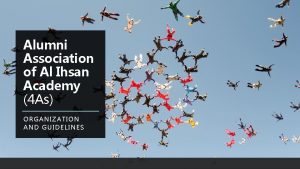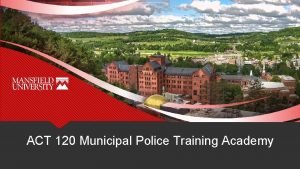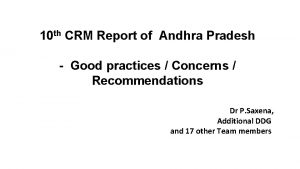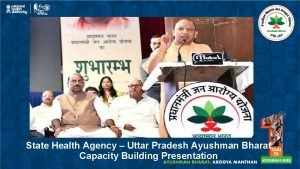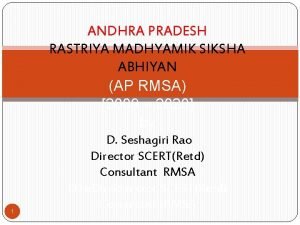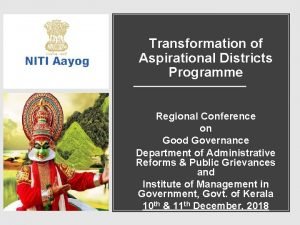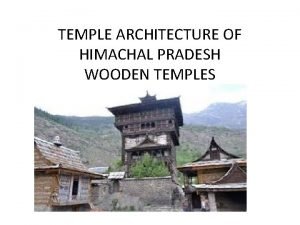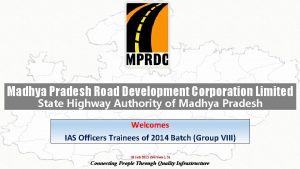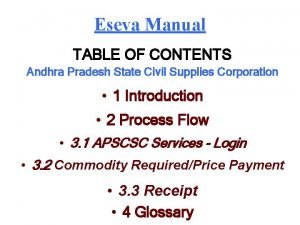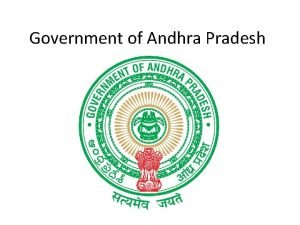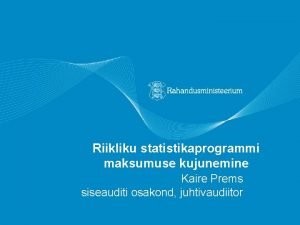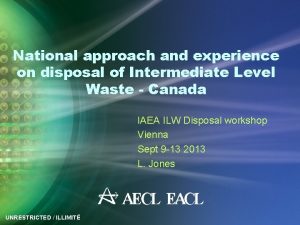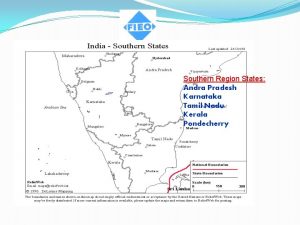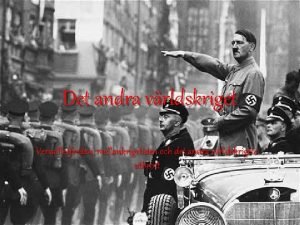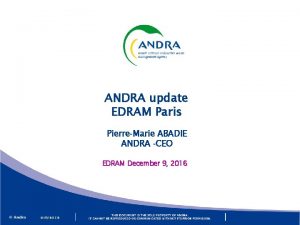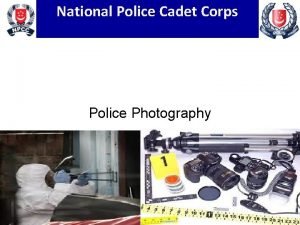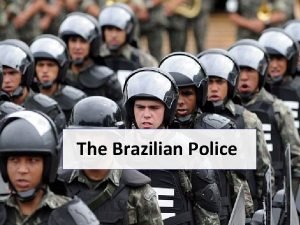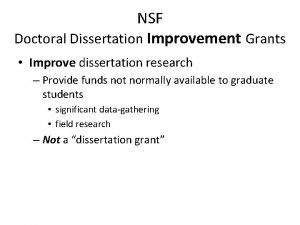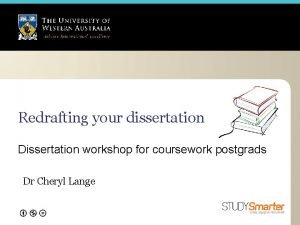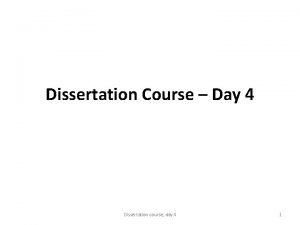DISSERTATION ON POLICE ACADEMY at AMARAVATHI ANDRA PRADESH




























- Slides: 28

DISSERTATION ON “POLICE ACADEMY” at AMARAVATHI, ANDRA PRADESH 2015 -2016 A Thesis Report for the Partial Fulfilment of Degree in Bachelor of Submitted by Architecture Under the Guidance of KRUTHIKA JAINAR J Ar. VINAYA 2 BV 12 AT 022 HIREMATH VIII Sem B. Arch BVBCET DEPARTMENT OF ARCHITECTURE B. V. Bhoomaraddi College of Engineering & Technology Hubli 580031

DISSERTATION ON “POLICE ACADEMY” at AMARAVATHI, ANDRA PRADESH 2015 -2016 A Thesis Report for the Partial Fulfilment of Degree in Bachelor of Submitted by Architecture Under the Guidance of KRUTHIKA JAINAR J Ar. VINAYA 2 BV 12 AT 022 HIREMATH VIII Sem B. Arch BVBCET DEPARTMENT OF ARCHITECTURE B. V. Bhoomaraddi College of Engineering & Technology Hubli 580031

K. L. E. SOCIETY’S B. V. BHOOMARADDI COLLEGE OF ENGINEERING & TECHNOLOGY, VIDYANAGAR, HUBLI CERTIFICATE This is to certify that Miss. Kruthika Jainar J. A student of VIII Sem of B. Arch has Satisfactorily completed her dissertation work entitled “Police Academy At Amaravathi, Andra Pradesh the academic year 2015 -2016, for the partial fulfilment of Bachelor of Architecture. Guide in charge Head of the Department Ar. Vinaya Hiremath Ar. Gururaj Joshi Principal ” for

Dedicated to Beloved Parents

CONTENTS 1. Acknowledgement. 2. Introduction to the project. 3. Feasibility to the project. 4. Scope and Importance 5. Literature Review 6. Characteristics of Ideal & Efficient Police Academy 7. Case Studies 8. Inferences, Guidelines and Data Collection 9. Site Analysis 10. Concept 11. Requirements 12. Area Analysis 13. Site Plan, Master plan, Floor Plans, Elevations and Sections 14. Rendered Views 15. Bibilography ANDRA PRADESH POLICE ACADEMY THESIS 2016

Acknowledgement At the very one set I express my deep Gratitude to my Institution BVBCET for having molded me to embark on a Professional Career. My sincere Thanks to our respective Principal ___________for the academic encouragement. At the outset I immensely thank our beloved HOD Ar. Gururaj Joshi Sir for allowing me to take this project. I express my deep and sincere Gratitude to y Guide Ar. Mrs. Vinaya Hiremath. Whose kind co-operation & learned comments made me to complete this dissertation. I also specially thank Ar. H. S. Patil Sir for helping me through out the Dissertation. I also thank all the Faculties of the Department. I am also greatful to Dy. SP. Sneha, KSPS, Mysore, SP Ravi. S, IPS, Principal PTC Gulburga. I heartly thank all the Staff of KPA, Mysore & PTC, Gulburga for their kind Co-operation during my case studies. Last but not the least I thank my PARENTS for their care love encouragement assistance and support every time and anytime without whom I couldn’t complete this project. ANDRA PRADESH POLICE ACADEMY THESIS 2016

INTRODUCTION TO THE PROJECT

What is a POLICE ? P - POLITENESS O - OBEDIENCE L - LOYALITY I - INTEGRITY C - COURAGE E – EFFICIENCY Moto of the Academy. ‘Sound mind in a Sound Body’ “A Police Officer has to be alert, agile, attentive and proactive all the time to his surroundings and events. All the trainees should develop such traits and combine them with a keen sense of observation, remembrance and thus develop an ability to excel in any emerging situation. ” ANDRA PRADESH POLICE ACADEMY THESIS 2016

Introduction A Police Academy merely means, the training centre for Police Officers. Police department is one of the prime Government Institution. Police have a great role to in the enforcement machinery needs to be professionally competent to perform such functions and to strive towards excellence. Professional competence means up to date knowledge and skills right attitudes and behaviour and commitment to the constitution. Training institutions have been entrusted with the responsibility of producing professionally competent policeman. However, TRANING is to be regarded as a continuous process meaning fine-tuning of knowledge and skills continuously through retraining. Importance Of Training The training institutions are not only established to import basic training to the new entrant at the level of Sub-Inspectos of Police, RSI, CPI and Dy. SP. The prime function of the academy is to provide efficient able & dynamic leadership to Police Forces of the state and central police Organisations. Police Oficers must realise that his response or reaction represents government action to the common people foe whom he is visible symbol of authority. ANDRA PRADESH POLICE ACADEMY THESIS 2016

This would Imply: 1. Police officers should acquire a high degree of professional competence and be full aware of the means, where by science and techonology can help their work. 2. They must develop attitudes in consonance with the concepts of social justice contained in the constitutions and the development programmes with a particular reference to the weaker sections of the community including the poor the minorities and sc/st ANDRA PRADESH POLICE ACADEMY THESIS 2016

Feasibility of the project It is seen that the training institutions in the state level much to be desired. Basically all police sub inspector who in station officer in all concerned stations are trained here. Police forces being entrusted with the maintenance of stability in socity after come int the conflict with forces generated by the political system itself which they are intend not only to serve but to preserve. A Police officer is concerned with not merely performing his duties to provide acceptable service but must be able to deal with and guide his officer to meet the varied and dynamic needs of changing the society. It is therefore necessary that the trainees should develop the attitudes, to acquire technical and analytical skills initiative and ability to anticipate situations and to innovate in new situations. This envisages a phased and intensive training programme in the form of a. Induction Courses h. Technical Courses b. Orientation Courses c. Promotion Courses d. Supervision Courses e. Professional f. Advanced Professional Courses g. Executive Development Courses ANDRA PRADESH POLICE ACADEMY THESIS 2016

a. Induction Courses : Politeness, discipline, attentiveness and alertness all are the main qualities which have to be included in every policemen. All the trainees should develop such traits and combine them with keen sense of observation, remembrance and thus develop an ability to excel in an emerging situations. b. Orientation Courses : Communication Skills and personality development and mental and physical stability are the main features which a policeman is supposed to develop c. Promotion Courses : The main aim of police man is to dedicate his service to protect and safe guard the people in the society. This service are graded accordingly to their ability and skill and also capacity to handle the toughest complications held in the nation. Police training colleges were made to provide training to gazetted probations Sub Inspectors and to held constables who are eligible to promote as Sub Inspectors. They also renamed ACADEMY after 1990, and there will be only One Academy for each state. d. Supervision Courses : Supervising and controlling the public activating is powered only to the police force by the Government. Thus the Academy will train the police force with wordage uprightness, dedication and a strong sense of service to the people e. Professional Course : Academy will try to include integrity of the highest orders, sensitivity to aspirations of the people in fast changing social and economic milieu, respect for human right board liberal ANDRA PRADESH POLICE ACADEMY THESIS 2016

Perspective of law and justice, high standard of professionalism, physical fitness and mental alertness. f. Advanced Professional Courses : Personality development, Research Studies, Human Resource Development, Cyber Crime studies, Fellowships and other Circular Activities adds the professional base training g. Technical Courses : Some of the basic concepts regarding software techonology Medicine Drug Abuse and enforcement integration ourse including law and order criminology, psychology, immerse Humanities MBA’s etc. Objective and Scope and Limitations Objectives To import basic training to the new entrants from the level of ACP to DIG To conduct refresher and capsule courses for In Service Police Officers to update their professional knowledge and skills To create a pool of police trainers for the Nation. The academy strives to import professional skills, ethics and morals of highest standard. It also tries to inoculate a spirit of service in the trainees. The academy is expected to be comprehensive training facility both for basic and in service training of the various ranks of the IPs. Broadly its objectives may be summarized as below To transform a hitherto ‘law and order’ oriented force into a service oriented one. To identify the training needs of the IPS at various levels and structure suitable courses. To achieve excellence in both service and basic and in service. ANDRA PRADESH POLICE ACADEMY THESIS 2016

To promote the concepts of continuing education among police officers by circulating periodic bulletins on subject of police concern To organise seminars, workshops, studies, surveys covering matters of police interest and bring t bear this knowledge on police functioning in the Nation. To develop consultancy capabilities in police matters. To promote education and research facilities in matters of police. To organise executive development programmes for senior police officer. To provide structured opportunities to police officer’s for exposure to other disciplines. Scope ‘Striving towards excellence’ is one of the fundamental duties and essential future of the Indian Constitution. This applies equally to individuals as well as organization or groups. The concept of “Welfare State” enshrined in the Directive Principle Police have a greater role to play in the enforcement of social legislations. The law enforcement machinery needs to be professionally component to perform such functions and to strive towards excellence. Professional competence means up to date knowledge and skills night attitudes and behaviour and commitment to the constitution. Training institutions have been entrusted with responsibility of producing professionally component policemen. However training is a continuous process meaning fine tuning of knowledge and skills continuously through retraining Challenges for the public in future are plenty like terrorism, communal riots, organised crimes, cybercrimes, serious agitations, policing the airports , economic crimes etc. all these can be effectively tackled only by discharging duties in a professional manner. ANDRA PRADESH POLICE ACADEMY THESIS 2016

Lots of scope and opportunities are provided by every state to encourage and strengthen policemen. They undergo ideal training courses for a period of 3 months -25 months, based on their ranks in cadre. Academy should be commenced need based courses for various units. The training schedule of the probationers has been tough and strenuous, requiring extra ordinary physical and medical stamina. It is the credit of probationers that they have been able to go through it with fortitude. There has been constant emphasis on inoculation of ethical values, sound judgement and discretion. Their unceasing endeavour has been to sensitize the IPS probationers to the changing social situation in the country and its implications for the role of the police. ANDRA PRADESH POLICE ACADEMY THESIS 2016

ORGANISATION STRUCTURE AND COURSE INVOLVED IN THE ACADEMY Organisation Structure: The Academy is headed by the rank of Director General of Police, who is assisted by a joint Director and 3 Deputy Directors. The faculty consists of Assistant Directors most of all who are serving IPS officers of the rank of superintendents of police, a judicial Officers, Forensic Scientists, management and behaviour Science Experts and other supporting staff. 1 st divisional staff including PSI, CPI of faculty group and 2 nd Divisional Staff includes computer operators, typists, stenos, Videographers, Photographers, DNA testers, finger & foot print experts, INSTRUCTORS (Deputy Superintendent of police) and Drill Instructors of the rank of Inspectors. The Academy is headed by a Director, an IPS officer of the rank of Director General of Police or Commissioner of Police (State) (3 -star rank) and assisted by two joint directors of the rank of Inspector General of Police or joint commissioner of police (2 -star rank), three deputy directors of the rank of Deputy Inspector General of Police or additional commissioner of police (1 -star rank), and 13 assistant directors. The assistant directors include eight IPS/SPS officers of the rank of superintendent of police from state cadres, forensic, a Judicial Service Officer, a specialist each in Training Methodology, Computers and Wireless. The sanctioned strength of the faculty includes management professors, reader in Behavioural Sciences, reader in Teaching Methodology, medical officers, junior scientific officer, Hindi instructor, photographic officer and chief drill instructor. The supporting staff include administrative, ministerial and medical staff and other Group D employees. Academy board A high-level Academy Board comprising senior civil/police officers, eminent educationists etc. as its members is headed by the Union Home Secretary. The board periodically reviews inter-alia the syllabi and training methodology of courses. ANDRA PRADESH POLICE ACADEMY THESIS 2016

About the training centre IPS officers are recruited from the state police cards and from the regional Civil service exams conducted by the Union Public service commission every year. Due to outgoing shortage of Police officers in India. The ministry of Home Affairs proposed creation of IPS limited Competitive Examination to be conducted by UPSC. The civil service examinations has three stages Competitive selection Process. 1. Preliminary Examination (general studies paper examination and aptitude test) 2. Personal Interview 3. Physical test State level Trainees 1. Commissioner of Police 2. Special Commissioner of Police 3. Joint Commissioner of Police 4. Additional Commissioner of Police 5. Senior Commissioner 6. Deputy Commissioner 7. Assistant Commissioner of Police Management workshops(war on waste) ANDRA PRADESH POLICE ACADEMY THESIS 2016

Government of India 1. Director of intelligence Bearer 2. Director general of police 3. Commissioner of police (city) 4. Inspector general of police 5. Deputy Inspector general of police 6. Senior super intendant 7. Superintendent of police THE BASIC SERVICES CONDUCTED BY THE ACADEMY 1. Refresh course for RPF 2. Training of trainers on gender sensitization 3. Training of trainers for KSRP 4. De-briefing session ANDRA PRADESH POLICE ACADEMY THESIS 2016

Auditorium Block The three-dimensional volume of an auditorium is conditioned by the need for all members of the audience to be able to see the whole of the platform or stage; and to hear the actor, singer, musician or speaker, 33. 1. Seating density, floor rake and seating layout are partly determined by this, partly to give the audience an appropriate level of comfort and essentially to ensure a means of escape in an emergency, such as a fire, within the time required by safety considerations and by legislation. SEATING The aim is to provide an appropriate standard of comfort. The range of human body dimensions is wide; while in most auditoria a single size of seat is provided, 33. 2 and Table I. Tolerance levels vary: young people can tolerate simple seating found less comfortable by Visual and aural limitations: a Plan: for a performer at centre stage B there is an arc Y beyond which visual and aural perceptions are impaired. However, for performers nearer the sides of the stage at A and C produce more restrictive curves X. b Section: Similarly, visual and aural limits in section also set an arc centred on the performer DIMENSIO NS DESCRIPTION MINIMUM MAXIMUM 720 mm DRAWN AS A Overall Seat Depth 600 mm B Tipped Seat Depth 305 400 C Seat Way 760 850 D Back To Back Seat Spacing 500 E Seat Width For Seat With Arms 450 F Seat Width For Seat Without Arms 50 G 430 750 650 mm 525 50 440 H Armest Height 600 I Seat Back Height 800 850 800 J Seat Inclination From Horizontal 7˚ 9˚ 7˚ K Back Inclination From Vertical 15˚ 20˚ 15˚ 33. 2 Auditorium seating: definitions of terms and dimensional information (to be read in conjunction with Table I): a Plan. b Section ANDRA PRADESH POLICE ACADEMY THESIS 2016

AUDITORIUM DESIGN Audience requirements As stated above, every member of the audience should be able to see and hear clearly whatever is happening on every part of the stage or platform. This is an ideal rarely (if ever) totally attainable in practice. However, a clear view for everyone of the main part of the stage or platform is normally achievable in modern auditoria. Where an existing building is undergoing renovation, further compromises may well be necessary for some seats. Auditoria 33 -3 The greater the encirclement of the audience of platform or stage, more people can be accommodated 3. 06 Row-to-row spacing within the aural and visual limitations up to 180 encirclement. Spacing is controlled by the clearway between the leading With a full encirclement, the distance from platform or stage edge of the seat (in an upright position, if tippable) and should be restricted to six the rear of the back of the seat in front, 33. 16. For rows. traditional seating the minimum clearway for people to pass along the row is 300 mm and this dimension increases with the number of seats in a row. For continental seating the clearway is not less than 400 mm and not more than 500 mm. Legislation also dictates the minimum row-torow dimension at 760 mm: this is usually not adequate and the minimum should be 850 mm for traditional seating. 3. 05 Number of seats in a row With traditional seating the maximum number is 22 if there are gangways at both ends of the row, and 11 for gangway at one end. Thus in all but the smallest auditorium the gangways divide the seating into blocks. Rows with more than 22 seats are permitted if the audience is not thereby imperilled. The term ‘continental seating’ is used for 3. 09 Seating density rows of seats with an increased Seats with arms and tippable seat can occupy back-to-back dimension extending a space as small as 500 mm wide (less for seats the width of the auditorium without arms) with a row-to-row dimension of exits at both ends. This 760 mm; but can be as large as 750 mm wide arrangement is usually only by 1400 mm, 33. 19. The area per seat therefore appropriate to proscenium stage, varies between 0. 38 m 2 and 3. 05 m 2. Increased platform or cinema. dimensions reduces seating capacity. Minimum dimensions as laid down by legislation offer a low standard of comfort and should not be taken as a norm, but the social cohesion of the audience may be lost if the standards are too high. In conference halls where writing space is required, lower densities are inevitable, 3. 04 Levels in the auditorium With a single level only, the pitch of the rake requires particular attention to achieve a sense of enclosure. The Greek amphitheatre is the exemplar. Seating capacity within aural and visual limitations can be increased by the addition of one or more balconies within the overall permissible volume of the auditorium. Similarly, boxes, side galleries and loges can be added to the side walls, especially in the case of the proscenium format. ANDRA PRADESH POLICE ACADEMY THESIS 2016

Administration Block Academic Block 3 DETAIL DESIGN CONSIDERATIONS 3. 01 Class room furniture and ergonomics It is important that appropriately sized furniture. Inappropriate sized furniture can affect the concentration of pupils and lead to neck and back pain in later life. Furniture sizes (one of the issues which sits under the heading of ‘ergonomics’) is a complex issue. Heights It is very important that children are provided with heights of furniture appropriate for the activities being carried out, some of which have health and safety implications – for example, science experiments using a Bunsen burner. School furniture gives height dimensions for work surfaces andshelving for different age groups, althouh, as the website explains, compromises may need to be made when using age group-related data as the size of pupils can vary. Toilets And Coat Hanging One WC and washbasin per 10 children, usually unisex. All cubicles should be big enough to allow adults to give assistance and at least one cubicle should be big enough for children with physical disabilities. Appropriate provision should be made for washing down children after ‘accidents’ in a way that protects their privacy and dignity. Coat areas should be accessed from the outside via draught lobby provided with a rack for Wellingtons. Staffroom Space should be allowed for these depending upon the nature of the setting, but all will require accommodation for staff to rest, have refreshments, prepare their work and hold meetings. Staff must have a flexible attitude towards their office accommodation as rooms may have to be designated for multifunctional use. ANDRA PRADESH POLICE ACADEMY THESIS 2016

Library Block The developing role of the library has created a set of new and complex challenges for those delivering library buildings and services. The libraries of the twenty-first century are no longer simply familiar repositories for books. They have changed and expanded, been rethought and redesigned. Libraries now provide an increasingly wider range of different services, using a multitude of media, and reach a more diverse audience than ever before. 3 LIBRARY DESIGN 3. 01 The design of library buildings should be addressed at the following levels: • Urban design • Access • Building design • Interior design Each has specific requirements, which involve dialogue with user and interest groups, and each level has its own exacting demands, which cannot be overlooked. Library design is more than an exercise in architectural form making in spite of the growing interest in typological reinvention. 3. 02 Multifunctional libraries Different types of library have different spatial and environmental emphases, and it is only too easy for an architect to assume that the experience of designing one type of library can be used, with only small adjustment, in designing another. Fundamentally, a library is not a building but a service organisation. It also needs to be borne in mind that, in recent years, there has been a growth in multifunctional libraries, for example, combined university and public libraries, and the combining in Local Authorities of libraries with other council services as ‘one-stop shops’. This is the approach adopted in the Idea Stores concept. . 3. 03 Site selection is often part of a wider development, for example, in the expansion of a university or as part of urban regeneration. The head librarian is normally consulted on the choice of site and usually leads the development of the brief. Matters to consider are: • Access – e. g. nearness to other civic, retail or institutional amenities preferably on foot. • Location – satisfactory and acceptable to the population being served. • Traffic flow (ingress and egress) and traffic controls – accessibility by public transport and car. • Site availability – the site needs to be available for immediate use/purchase. Consider environmental hazards, constraints on historic buildings and limits on maximum area or height of building. • Topography – grading needs and other natural features that might affect the development. • Solar and wind orientation – much of the energy demand in buildings is for light and climate control. The site should allow for maximum use of natural light and ventilation. The effect of the sun’s glare on the building will also need to be assessed especially in the context of PC screens. Visibility – the site should be in a prominent position, i. e. with natural views to and from the site. • User and staff safety – the site will need to be safe and secure at night and well-lit. Parking should be accessible nearby and child safety considered in terms of proximity to major roads. • Community synergy – it is crucial to check the proximity of other community (institutional) amenities, perhaps as part of a cultural quarter or retail area. Consider current known footfall in the area. • Size for growth – ability to accommodate expanded library facilities if required in the future, e. g. an extension to the building or further parking ANDRA PRADESH POLICE ACADEMY THESIS 2016

ANDRA PRADESH POLICE ACADEMY THESIS 2016

Case Studies 1. Karnataka Police Academy, Mysore. 2. Police Training College, Naganhalli, Gulburga. ANDRA PRADESH POLICE ACADEMY THESIS 2016

Karnataka Police Academy, Mysore. History of the Academy • Karnataka Police Academy, Mysuru is a premier Police Training Institution of Karnataka State with a rich history. • Police Training School took its birth in 1892 at Bengaluru. • In 1939 an additional training school at Mysuru , was started for training recruits from Mysuru, Mandya, Hassan, Kadur and Shivmogga districts which later shifted to outskirts of Bengaluru City and was functional till May 1952. • Once again in the year 1952, it was shifted to Mysuru, to the buildings vacated by his highness the Maharaja’s own Infantry. • In 1958 Redesignated the Police Training school at Mysuru as “Police Training College, Mysuru”, and Police Training School also continued till 1967. • The PTC was further elevated to the status of an Academy in the year 1992 and the Principal was designated as the Director. • KPA campus is spread around 50 acres of land. • KPA campus has the newly constructed Administrative Block, newly constructed Auditorium, Old Administrative block, Swimming Pool, Parade Ground, Computer Lab, Library, etc, . • The old KPA Campus has facilities like 7 Hostel Blocks, 2 Officers mess, 35 Kuteeras, Armoury, Guest house, Gym, Essential Service Complex, Senior officers Gest House, Tennis ground, Basketball ground, MT Section, etc, . ANDRA PRADESH POLICE ACADEMY THESIS 2016

Location of the academy It is located in Jalpuri, Mysore. 1. 5 kms from Central bus stand, 3 kms from Mysore Railway Station and 11. 7 kms from Mysore Airport Layout and Zoning. This site is round 48 acres including the old KPA. The site is very simple and there administration and academic block which faces a wide 205*150 m parade ground. There is a road dividing residential zone. The forensic block containing crime scene hall and museum is located in the admin block only. Auditorim of only 250 capacity is also located in this block. Modern lecture hall equipped with state of the art equipment , AV aids, crime scene stimulation laboratory, library, gymnastic, officers mess, computers labs, health clinic post office, etc ANDRA PRADESH POLICE ACADEMY THESIS 2016

N Site Plan of the Academy Administration Block ( Old ) Ramya loka (Armoury training ) Library (GF) and computer Class (FF) Classrooms Block Administration Block ( New ) M T Shed Auditorium Road Police Guest House ANDRA PRADESH POLICE ACADEMY THESIS 2016

ANDRA PRADESH POLICE ACADEMY THESIS 2016
 Police academy college point
Police academy college point Ventura county police academy
Ventura county police academy Police academy nes
Police academy nes What is an act 120 certification?
What is an act 120 certification? Fire hose reel signage standards
Fire hose reel signage standards Natpurwa village uttar pradesh
Natpurwa village uttar pradesh Eaushadhi andhra pradesh
Eaushadhi andhra pradesh Thangka painting of arunachal pradesh
Thangka painting of arunachal pradesh State health agency uttar pradesh
State health agency uttar pradesh Agro climatic zones of himachal pradesh
Agro climatic zones of himachal pradesh Demographics of himachal pradesh
Demographics of himachal pradesh Rmsa ap
Rmsa ap Gvmc building setbacks
Gvmc building setbacks Language of uttar pradesh
Language of uttar pradesh Mdm portal madhya pradesh
Mdm portal madhya pradesh Temple architecture of himachal pradesh
Temple architecture of himachal pradesh Introduction of himachal pradesh
Introduction of himachal pradesh Madhya pradesh road development corporation
Madhya pradesh road development corporation Eseva andhra pradesh
Eseva andhra pradesh Cm core dashboard irrigation
Cm core dashboard irrigation Andra paixo
Andra paixo Andra prems
Andra prems Andra prems
Andra prems Andra aedma
Andra aedma Andra paixo
Andra paixo Tiina viin
Tiina viin Andra mite
Andra mite Andrea slan
Andrea slan Andra
Andra


